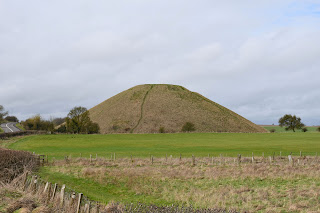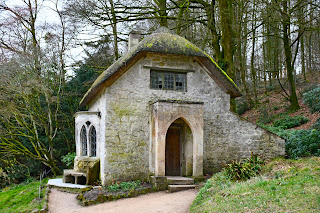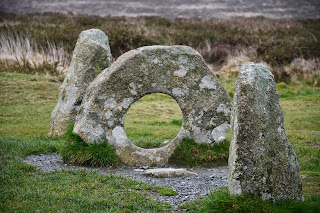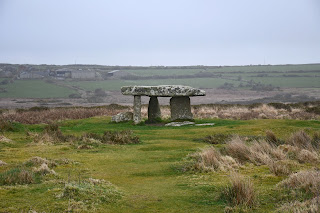A Journey to Land’s End
Britain’s never-ending railway strikes and skyrocketing public transport prices have radically changed my trip-planning calculus. Journeys to relatively nearby places have become so expensive that it is often cheaper to simply rent a car – especially when travelling with another person.
I did not come to this
realisation gradually but all at once: to pay me back for all the trips I had
planned in the past few months, Johnny took it upon himself to plan an
excursion to Manchester. A week before leaving, however, we received a
notification that our train had been cancelled. We consulted trainline for
alternatives, but all the tickets were absurdly expensive. We decided,
therefore, that we would rent a car and make a trip that would have been well
nigh impossible using public transport: a journey from Oxford all the way to
Cornwall.
We borrowed a car in Oxford at 10 o’clock in the morning on Thursday, heading south to Silbury, the tallest prehistoric human-made mound in Europe. Although technically just a pile of dirt (well, chalk and clay, to be more specific), it is quite an impressive sight considering the amount of effort it would have taken to build such a structure four thousand years ago. Indeed, some estimates say the mound would have taken 500 people 15 years to construct. As with many such monuments, it is unclear what function the mound served.
From Silbury, we
continued to Avebury, the site of the largest megalithic stone circle in the
world. Avebury actually contains three stone circles in total, and the henge
itself is so big that – to my utter bewilderment – a whole village stands
within its walls. Quite a few people were in Avebury on the day of our visit,
many of them touching the stones in an apparent attempt to absorb their energy.
Also present in Avebury is the National Trust’s Avebury Manor (which reminds me
that we saved a few pounds on parking thanks to an English Heritage sticker I
received in the mail a few days previously). We did not visit the interior of
the building but had a quick look around its courtyard before leaving again.
It occurs to me now
that I have not yet complained of having to drive on the left side of the road.
Perhaps that’s because it is not as difficult as I thought it would be. Yes, I
might have accidentally ended up on the wrong side of the road about three
times during our entire trip, but I would consider that a success. Indeed, I
would say the difficulty of driving on the left pales in comparison to three
other obstacles: roundabouts, narrow roads, and British drivers.
Exiting a side street
and somehow ending up on the right side of the road is scary, but not as
stressful as trying to figure out when to be on the outer or inner ring of a
roundabout – and especially not when no one else seems to know either. On our
third day, we almost hit a car that definitely should not have been leaving the
inner circle the way it did, though to be fair, we should not have been on the
outer circle either. As for narrow roads, Cornwall deserves a medal, but
English country roads are not much better. I may or may not have accidentally
grazed a car in a quaint village where cars occupied both sides of the road.
The worst part is that
British drivers are quite passive aggressive. Even when I knew I was in the
wrong, no one ever honked at me, which would have helped with clearing up some
of the uncertainties I gathered over those few days. The most terrifying
experience of the entire trip, however, was when we entered a bend and saw a
car pulled over in the opposite direction. At that very moment, a truck
emerged, and only registering the car at the last minute, veered into our lane.
We narrowly evaded it by slamming the brakes and swerving into a row of bushes.
Anyway, having escaped
both the truck and the village with its narrow main road, we ended up near the
Bratton White Horse – a massive chalk figure carved into the side of a hill in
Wiltshire. Although somewhat reminiscent of the Nazca lines in Peru, this
monument was only built in the seventeenth century. The Uffington White Horse
is much more ancient, but it is difficult to see without a drone or a
paraglide.
Our last stop before
reaching our accommodation in Exeter was Stourhead. An expansive estate with an
English landscape garden, Stourhead is known for featuring in the by far inferior
filmed adaptation of Pride and Prejudice (the overly dramatic 2005 version
simply does not hold a candle to the BBC’s 1995 charming miniseries). Notwithstanding
these unpleasant associations, Stourhead is a pretty place, with all its
landmarks conveniently arrayed along the banks of a moderately-sized lake.
We began our journey
the next day with a short excursion around Exeter. The cathedral is an impressive
sight, and its ceiling is said to be the longest uninterrupted medieval vaulted
ceiling in the world (an achievement that would be a little more impressive if
it didn’t have to be described with so many adjectives). Also interesting is
the sheer number of people buried there who have some connection to Oxford –
among them, unsurprisingly, one of the founders of Exeter College.
We then began our over two-hour long drive to Penzance. Though I am not generally the biggest fan of Gilbert and Sullivan, we had no choice but to listen to a few numbers from their Pirates of Penzance as part of our cultural immersion. Upon arriving, we found the weather to be a little unfortunate. Saint Michael’s Mount, which on a good day looks like a discount version of Mont Saint-Michel, looked more like the barnacle-covered underbelly of an upturned whale. Nevertheless, the surrounding flora was quite interesting, from the mosses on stone walls to the tall grass growing atop sand dunes. We ate lunch in a seafood restaurant, where I could indulge my love for shellfish while allowing Johnny to get some meat into his system.
Having missed a turn
somewhere on the way from Penzance, I found the drive to Land’s End more painful
than it should have been. The roads were not only too narrow to fit two cars,
but they were also lined by walls that made it impossible to see around bends.
I adopted the sensible Southeast Asian practice of honking upon entering bends,
though fortunately traffic was sparse enough for that to make no difference. I
did have to back out twice, however, once before a van, and another time before
a massive tractor.
Driving through the countryside does have its perks though. For one, we spotted a fox hightailing it over a fence – the first wild fox Johnny had ever seen. Also, as we were driving along, we marvelled at beautiful fields of daffodils stretching as far as the eye could see. We drove the car off the road at one point and simply walked along the paths between the flowers for a while.
We finally made it to
Land’s End as the weather started to become more interesting. Every now and
then, the sun would cast its rays into the sea or pass over the cliffs, giving
them a rich bronze hue. Despite the vast size of the tourist centre, the site
seemed quite empty: we were practically alone while walking past its tiny stone
circle and Britain’s westernmost mailbox (now sadly out of use). I was also
surprised to see signs written in what I assumed to be Cornish.
As the day wound down,
it became clear we would not make it to Pendennis Castle on time (and indeed,
when we drove up to it anyway, we found we could see very little of it from the
outside). We were not in a rush, therefore, as we explored some of the truly
ancient sights in the neighbourhood. One of the places I put on my list was Mên-an-Tol:
a stone formation remarkable for its ring-like central stone. To get there, we
had to leave the car by the entrance to a field and followed the public
footpath for some ten minutes. Walking past the abandoned houses and lifeless
fields, I contemplated the terror of living in this drab landscape at a time
when everyone’s greatest amusement involved gathering around a ring of rocks.
That is not to say
that Mên-an-Tol was not an interesting sight. Quite to the contrary, it was fun
to hypothesise about its original purpose. We figured that looking through the
hole, one might be able to see the sun rising and setting during the summer
solstice. When viewed through the circle, we figured it would rise just to the
right of the stone to the east of the circle, and set just to the left of the
stone to the west of the circle. While doing my research on the place, I also
read that the Cornish poet Donald Michael Thomas referred to Mên-an-Tol as “the
wind’s vagina,” which is just brilliant.
Driving a little
further down the road, I suddenly caught a glimpse of a sight that I had only
ever seen in pictures. I parked the car and looked again – my eyes had not
deceived me; we had accidentally come upon a dolmen. We pointlessly scaled a
fence of barbed wire to come close, oblivious of the footpath just a little
further down the road. Somehow, despite it being just a stone slab resting on
three feet, the dolmen was more impressive than I had imagined, especially when
contrasted against the desolation of the surrounding landscape.
Since we had to return
our car at 10 AM on Saturday, we woke up very early. Much to my annoyance, the
sun decided to make an appearance that day, not only shining in my face while
driving east but clearly taunting me after two days of clouds and rain. I
cannot complain too much, however, as this was the first time I saw a double
rainbow.































































Comments
Post a Comment